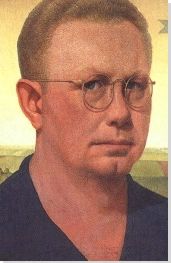Summary of Grant Wood
Hailed as one of America's foremost Regionalist painters in the 1930s, Grant Wood strove to depict archetypal rural subjects that embodied the values of hard work, community, and austerity. Eschewing the idioms of avant-garde European art, Wood depicted his native Midwest with the clarity and precision he observed in Northern Renaissance art and the organic lines and curves of Art Deco design, melding these disparate styles into a uniquely American vision. In painting small town and rural life, Wood gave the American public an idealized vision of itself at a time during the Great Depression when most common, working Americans faced great hardship.
In subsequent decades, his work has been praised and derided by critics and public alike, but his paintings, and in particular American Gothic, remain some of the most iconic, and appropriated, paintings created by an American artist, thus providing Wood with a permanent place in American popular culture.
Accomplishments
- Despite his relatively short mature career and his dismissal by important critics and scholars in the 1940s, Grant Wood endures as one of America's most popular artists, who painted quintessentially American scenes. His adherence to realism coupled with highly complex formal compositions and slightly strange perspectives draws viewers into a world that is not always what one expects. While many are happy to find depictions of a bucolic America, many also revel in the strangeness and subtle criticality that Wood presents.
- After the stock market crash of 1929 and the onset of the Great Depression, American artists turned their efforts to creating a particular strain of American art that embodied patriotic values that hearkened back to an earlier time. Nostalgic and romantic, Regionalism pictured an American society devoted to productive labor and tightknit communities. Along with John Steuart Curry and Thomas Hart Benton, Grant Wood depicted stalwart Midwestern types that embodied this idealized America.
- While most famously known for his paintings, which garnered immediate national attention, Wood also worked in decorative arts, jewelry design, and illustration. He did so in part to make much-needed money for his family, but he was also committed to creating a vibrant artistic culture in small-town Iowa that was not beholden to larger metropolises such as Chicago and New York.
- Wood's reputation has never been steady. He endeared himself to Midwesterners, who saw themselves portrayed in a positive light, but Easterners tended to dismiss him because of his purported sentimental, old-fashioned style. More recent interpretations have detected a subtle critical edge to many of his paintings, suggesting that Wood was not necessarily the booster he was made out to be.
- While there were rumors about Wood's homosexuality during his lifetime and after his death, Wood never publicly acknowledged this aspect of his identity, and in fact seemed to live in fear of being exposed. More contemporary scholarship has begun to reexamine Wood's painting in light of his sexuality, excavating, in curator David Ward's words, the "tension and difficulties faced by gay men who stayed behind in Middle America."
Important Art by Grant Wood
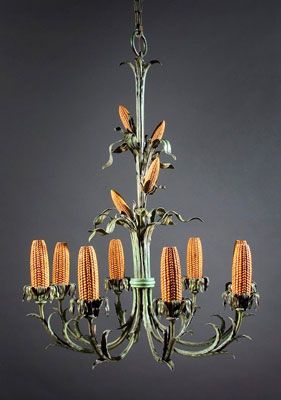
Chandelier for Iowa Corn Room, Hotel Montrose, Cedar Rapids, Iowa
Using his skills in metal work, Wood created this chandelier as part of a themed interior design project for the Hotel Montrose in Cedar Rapids. The holders for lights are shaped like corn cobs, held up by corn stalk shaped arms, complete with leaves. The stem from which the fixture hangs is further adorned with corn cobs and lively, waving leaves.
The Iowa Corn Room commission came to Wood during his first years dedicated solely to his artistic career. Though he painted during this period, the cultivation of an active community and the support of local businesses led to a variety of work, including a number of interior design projects. This chandelier is part of a fully crafted environment, with panoramic murals, and this hand-crafted fixture. At the opening of a similar project at the Martin's Hotel in 1926, Wood spoke to the press of the burgeoning "feeling for the culture and art in this section of the country, which is rapidly making it a place which New York artists look to with longing."
Envy of New York or not, Wood and his colleagues were not wilting in a cultural backwater but enjoyed a thriving arts community with ample support. Wood's numerous patrons for projects such as the Iowa Corn Room hailed from the prosperous business class in Cedar Rapids and were eager to beautify the city and enhance its cultural life.
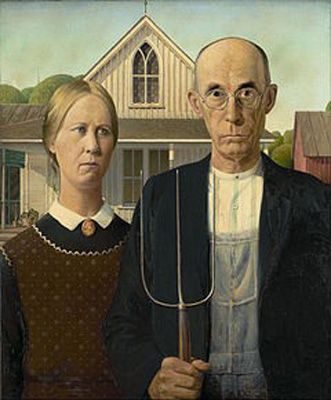
American Gothic
American Gothic arguably remains one of the most recognized American artworks of the 20th century. A youngish woman in conservative dress, eyes averted, stands next to an older man, who wears a dark suit jacket atop overalls and a collarless shirt. The bald-headed, bespectacled man grips a three-pronged pitchfork - an old-fashioned tool at the time - and gazes flatly at the viewer. Behind them is a modest white home, with a decorative gothic window - a common feature of the "Carpenter Gothic" style of the period - positioned between the pair's heads. The curtains in the window echo the pattern of the woman's dress. A few potted plants are visible on the porch, just over the woman's shoulder. Tidy green trees, with a hint of perhaps a church steeple, along with a red barn, fill out the background.
Two days prior to the opening of the Art Institute of Chicago's exhibition, where the painting debuted, the Chicago Evening Post published an image. The stone-faced subjects - who many assumed to be husband and wife - generated a stunning amount of interest, and Wood became known nationwide, practically overnight. Wood said of the work - which he said showed a daughter and father, not a married couple as many assumed - that he "simply invented some 'American Gothic' people to stand in front of a house of this type," essentially doing nothing to dispel the work's ambiguity. The models for the couple, though, were his dentist and his younger sister Nan. It exemplifies the remarkable, inherent instability of Wood's mature work; interpretations of his depictions of Midwestern types, American folklore, and Iowa farming activities provoked contradictory reactions in 1931 as much as they do today. As Emily Braun states, "Even those who concur that satire may have been the operative mode for the artist debate whether his debunking was gentle or biting."
The reception of the work and its life since reflect the curious ambiguity of this seemingly straightforward image. It raises more questions than it answers. It's title declares itself American, but what, exactly, is emblematically American about it? If it is a paean to the simple folk of the mid-west, why has the artist posed the couple looking miserable? Is it meant to convey irony? Is it a commentary on American identity? Or does the title simply describe the revival-style architectural detail of the house? The debates of national identity that dominated the time of Wood's mature career play an important role in the interpretation of his work. The 1930s saw a retraction from growing cosmopolitanism into what Barbara Haskell describes as "a powerful strain in popular culture" with "a pronounced reverence for the values of community, hard work, and self-reliance that were seen as fundamental to the national character and embodied most fully in American's small towns and farms." Perhaps because of, rather than in spite of, the painting's ambiguity, Wood's enigmatic couple became iconic.
Oil on beaverboard - The Art Institute of Chicago
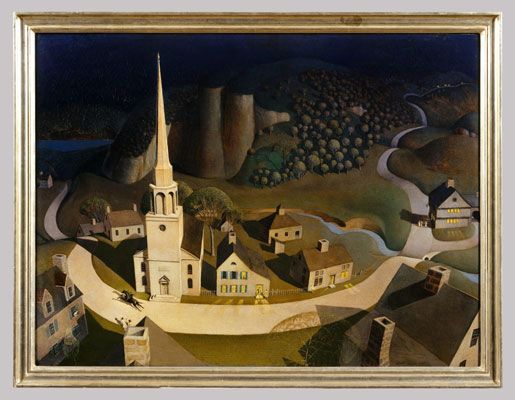
Midnight Ride of Paul Revere
Henry Wadsworth Longfellow's famous poem inspired Wood's 1931 depiction of Paul Revere's legendary ride through Massachusetts towns, warning of the arrival of British troops. A theatrical spotlight illuminates the center of the painting, showing the town from an aerial perspective, placing the tops of chimneys in the foreground. Towards the left, a doll-like Revere on his horse speeds past a white-washed church. A few citizens emerge from their homes in his wake. A darkened road, leading though rolling hills with decoratively spherical trees extends through the background on either side of the brightly lit town.
The patriotically inspiring poem, lauding Revere's journey "To every Middlesex village and farm, A cry of defiance not of fear," had long inspired Wood. As a child Wood reported that he had imagined "warning people of a dreaded cyclone," in similar fashion, perhaps influencing the playful fashion in which he depicted the legend. Stylistically, this work shows both the forward and backward-looking tendencies in Wood's mature style. The landscape is built upon a gleefully excessive decorative geometry, reducing every object to smoothly rounded or strictly linear shapes. The precision of the paint was a newer development for the artist, but the imposition of modern design on the landscape reflects his professional roots. Though Wood had no interest in working in a Cubist or truly abstract style, he wanted his work to have a modern look. Applying contemporary design principles to his landscapes was his solution - his trees and hills have the relentless repetitive geometry of an Art Deco skyscraper. The aerial perspective recalls a common device in Currier and Ives prints, which were enjoying a resurgence in popularity in the 1930s.
The choice of subject and the decorative treatment have been interpreted in opposing manners. One reading views this work - due to the lighthearted approach to the subject and the deadpan theatricality of the setting - as irreverent and reflective of what art historian Wanda Corn refers to as the "iconoclastic debunking mind-set of the 1920s," aligning Wood with H.L Mencken, known for his ridicule of mass American tastes. Others have grouped Wood's depiction with a parallel trend of a broader colonial-era preservationist movement in the United States, emblemized most clearly by John D. Rockefeller, Jr.'s restoration of Williamsburg, Virginia. Although Wood gives the subject a distinctively storybook treatment, with the bird's eye view and graphic scenery, the intent is a reinterpretation of a national legend, based on the artist's conviction that America had a rich literature, worthy of preservation and appreciation.
Oil on composition board - The Metropolitan Museum of Art, New York
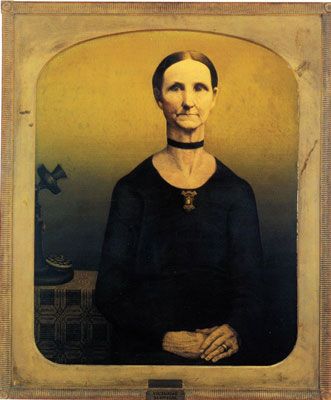
Victorian Survival
A prim, stern faced woman painted in sepia tones gazes directly at the viewer. She wears a ribbon choker around her exceptionally long neck. Her hair is parted down the middle and pulled back, in mid-19th century style. The background is bare, except for a table with a rotary dial phone, which echoes the sitter's long neck.
The portrait was based on a tintype of Wood's great aunt, Matilda Peet, and its arched top and warm tonal coloration approximate the palette and shape of a 19th-century collodion print. In Wood's unfinished biography, he recalled wondering about his Aunt Matilda, "how she could shut her eyes at night," with her hair pulled back so tightly. He found her both "exciting and oppressive," in that she was more intellectual and aspiring to culture than other members of his family but was also "extremely austere." He disrupts the evocation of a 19th-century photograph with the presence of the telephone, which appears in the place where usually a bible or a vase of flowers might provide set dressing for a portrait. At the time, a dial phone was the most modern of communication tools. Its earpiece points up towards the subject insolently, and one might imagine that her tense expression results from it ringing noisily by her side.
Wanda Corn stated that this work, like many of Wood's paintings, "is about culture shock, about the unbridgeable gulf between the rural, Victorian world in which he had been raised and the modern, urban one he lived in as an adult." The woman and the phone are opposites: she is "closed to outsiders and expression of emotion," the telephone, emblematic of "a jangling, intrusive world" she would never adjust to. Artists of Wood's generation addressed the stunning pace of change in the world in different ways. While Precisionists celebrated technology, others mourned the passing of old ways of life. Wood approached the subject with humor, but like Edward Hopper and Walker Evans, he shows sensitivity towards "the sturdiness, elegance, and independence of the late-19th-century America being displaced by the modern world." In Wood's rendering, the displaced past is simultaneously an object of humor and the subject of sympathy and sentiment.
Oil on composition board - Carnegie-Stout Public Library, Dubuque, Iowa

Dinner for Threshers
This triptych-like painting was a study of a hoped-for mural commission. The commission never materialized, but the painting was exhibited widely. Both the triptych format and Wood's detailed, mature style seen in this work are inspired by altarpieces from Northern Renaissance artists such as Hans Memling and Albrecht Dürer. Dinner for Threshers depicts Wood's childhood memory of harvest season. The left section shows farmworkers tidying themselves up to join the group inside for a noon meal. Near the peak of the barn's roof, "1892" is inscribed, situating the scene in the first year of Wood's life. The center scene shows a crowd of workers gathered around the table seated on mismatched chairs. Their white foreheads contrast with their sunburned faces, as they have all politely removed their hats indoors. A woman walks in from the kitchen with a full bowl. The third section shows two women in the kitchen working at the wood-burning stove, watched over by cat.
Wood's unfinished biography describes this annual event as an exciting day for farm families. One day in late July or August, after the wheat had been cut and shocked - stacked upright for drying - the "threshing machine would arrive like an immense fire-dragon." All the neighboring farmers would come with hayracks to pick up the shocks of wheat and carry them to be threshed. This communal arrangement went on for weeks, everyone moving from farm to farm until all the wheat was threshed. Every threshing day, "at the dot of noon," the workers all flocked to the farmhouse for a feast. The work exemplifies Wood's celebration of communal effort and the social rituals of Midwestern farm life.
Wood's meticulous style invited close scrutiny. Viewers wrote him letters questioning its accuracy. The artist defended the composition as coming from his memory - down to the pattern of the china on the kitchen shelf - and wondered why viewers would allow him to bisect a house, but argue over "the position of shadows under chickens," and other details. This response recalls his early career as a middle school teacher, bringing attention to the basics of looking at modern paintings.
Oil on hardboard - Fine Arts Museums of San Francisco
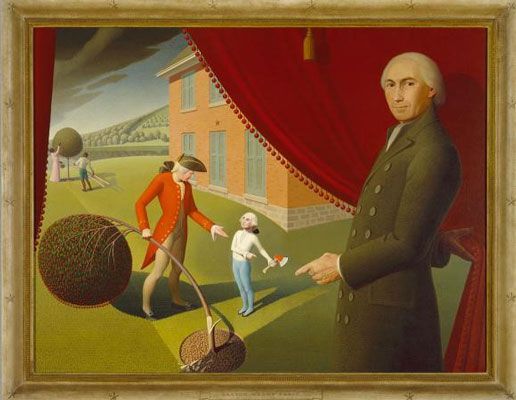
Parson Weem's Fable
This late work by Wood is an off-kilter depiction of Parson Weems' legendary fable of George Washington's honesty. Weems, the author of George Washington the Great (1806), stands in the foreground, holding back a tassled curtain - a pose quoted from Charles Willson Peale's The Artist and His Museum, Self Portrait (1822). Behind the curtain, a scene of his apocryphal tale of young George Washington confessing to cutting down a cherry tree unfolds. The small child Washington - whose head is depicted as the "father of the nation," after Gilbert Stuart's Athenaeum Portrait - gestures towards the axe in his hand, confessing to the destruction of the perfectly round-topped tree that his stern father holds while reprimanding him for his impulsive act. A tidy brick house leads diagonally into the distance, where two workers tend to a similarly geometric tree, and hills covered in tidy foliage roll off in the distance.
Wood stated that his intention for this work was to "help reawaken interest in the cherry tree and other bits of American folklore that are too good to lose." The context of rising fascism in Europe compelled Wood towards bolstering patriotism through admiration of Washington's honesty and the model of parenting that Weems intended the tale to be. The artist is also responding to an article by literary critic Howard Mumford Jones, who called upon writers and artists to develop a "new kind of patriotism...without chauvinism, economic self-interest, or racial snobbery" that could bring back the importance of legends, myths and historical events. Wood said on this topic, "The most effective way to do this is to frankly accept these historical tales for what they are...folklore - and treat them in such a fashion that realistic-minded, sophisticated people of our generation can accept them." To this end, in this work, he makes the inherent artifice part of the presentation. Weems' fable was a fictional story-within-a-story. Wood depicts the writer as literally pulling back the curtain on his creation. Weems is also an alter ego, a fellow creator of lore, who, like Wood, had the aim of "enriching the national imagination with colorful stories of America's heritage." The scene within also contains layers. The most jarring feature - the six-year old child with the Athenaeum portrait head - introduces an element of narrative absurdity but also signals that this isn't a real story about a real child, but an "origination myth" of a Founding Father. The orderly, decorative geometry of the landscape and composition proved a jarring foil for the silly appearance of the old-man/boy protagonist.
Oil on canvas - Amon Carter Museum of American Art, Fort Worth, Texas
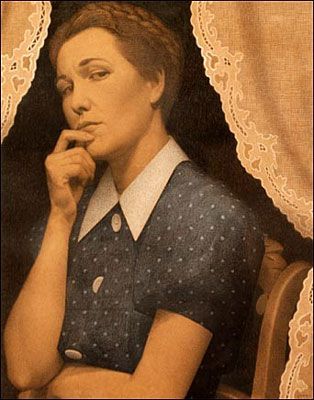
The Perfectionist
Illustration, design, and commercial work were a significant aspect of Wood's artistic practice throughout his career but gained additional importance to him for financial reasons in the mid-1930s. In 1936, he accepted an offer to illustrate a special edition of Sinclair Lewis's Main Street, prompting the St. Louis Dispatch to comment that "the novelist and painter have become so well-known for their studies of rural America that such a collaboration seems more than just appropriate." The commission included nine illustrations, mostly of the denizens of Gopher Prairie, Minnesota, the fictional town where the novel is set. The book had a print run of 1500, each signed by the artist. These preparatory drawings on brown wrapping paper reflect the final color scheme and materials of the publication, which Wood helped choose - tan rag paper, with a blue and yellow linen binding.
Wood created generalized personas for particular characters, using costumes, gestures and attributes to identify the small-town types. Looking up at each figure from below, the illustrations exaggerate the hands and eyes to reveal the characters' personalities. The Perfectionist, for example, is Carol Kennicott, one of the more affluent characters and a "crusader and promoter of culture and beauty," looking askance out of a lace-curtained window at the small town that will never measure up to her standards. Although this frustrated housewife is a sympathetic character in the book, Wood pokes fun at her by introducing a minor flaw - her second button is coming undone.
In other drawings, such as The Booster depicts James Blausser, a member of the town's "Commercial Club," who had "recently come to town to speculate in land...He was a bulky, gauche, humorous man with narrow eyes...and brilliant clothes." He expostulates in front of an American flag - a back-slapping man of business, promoting the town in hopes of personal gain. The Sentimental Yearner, a lawyer transplanted from the city, exemplifies the once-cultured person who succumbed to the "Village Virus," who found himself reading "four copies of cheap fiction magazines to one poem," and putting off trips to the theater in Minneapolis "till I simply had to go there on a lot of legal matters." He sniffs a carnation, which, perhaps, like Proust's madeleine, evokes a memory of his cultured past.
While both Wood and Lewis were indeed associated with rural America, Wanda Corn points out that they "made their reputations portraying very different strata of provincial America." Wood's subjects were farmers and old-fashioned types, while Lewis's characters were modern, yet more complacent, conformist and narrow-minded. Lewis belonged "to a generation which revolted against the village, Wood to one which had returned to it." This difference in world view can be seen, for example, in Wood's lightly critical view of the Perfectionist - a woman who aspires to culture and refinement and sees her small town as lacking.
Fine Arts Museums of San Francisco
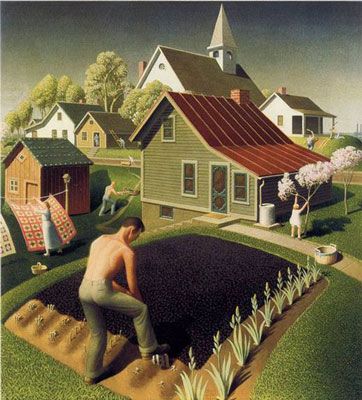
Spring in Town
Set in a small town with several houses visible, a young, shirtless man readies the vegetable garden for spring planting. A woman hangs out quilts to dry on the clothesline, and a young child pulls on the branches of a flowering tree. Further in the background, a man mows a yard, a couple beats a rug, a man climbs a ladder to his roof, and a child pushes a cart down the sidewalk. Wood paints the scene with crisp, clear lines and gives the viewer the perspective from slightly above the goings-on. In this way, we see the whole panorama of small-town life and labor as well as its minute details. Wood said of this painting and another painted as its pendant, "In making these paintings, I had in mind something which I hope to convey to a fairly wide audience in America - the picture of a country rich in the arts of peace, a homely, lovable nation, infinitely worthy of any sacrifice necessary to its preservation."
While Wood's intentions are amply evident in this painting and numerous others, there is another level of meaning right below the surface. An undeniable homoerotic element is present in this work with the young man in the foreground, who was modeled on George Devine, the sun of a football coach at the University of Iowa. We immediately see his muscled shoulders and back, amplified by a farmer's tan from a sleeveless shirt, and his work pants tightly cover his buttocks, leaving nothing to the imagination as he bends over to shovel up some of the garden dirt. Towards the end of his life, rumors of Wood's homosexuality began to circulate; given that homosexuality at the time was a punishable crime, Wood was keen to keep this information under wraps, and yet there is a way in which many of his paintings are both, in art historian Henry Adams' words, a revelation and a concealment - the revelation of the wonders of Midwestern towns but also the concealment of deeper desires and fantasies. As art historian Sue Taylor argues, Wood drew on his own memories of farm life as a young boy but combined these with aspects of his present life - people he knew, houses he noticed in the neighborhood, and his feelings about family and friends.
In 1939, one of Wood's lithographs, Saturday Night Bath, ran afoul of the U.S. Post Office on the grounds that the powers-that-be felt it was pornographic. Wood could innocently claim that he was depicting two nude men bathing after a long day working in the fields, but the homoeroticism is palpable. Art historian Richard Meyer cautions about labeling Wood a homosexual artist, but he does not deny his queer aesthetic that seems to eroticize not only manual labor but often times the landscape itself, thus complicating Wood's reputation as an upholder of conservative values.
Oil on wood - Swope Art Museum, Terre Haute, Indiana
Biography of Grant Wood
Childhood
Grant Wood, born in 1891, was the second of Francis Mayville Wood and Hattie Weaver Wood's four children. He spent his early years on a farm in rural Anamosa, Iowa. When he was 10 years old, his father died unexpectedly, and Hattie moved with the four children to Cedar Rapids. Grant and his older brother immediately needed to take odd jobs to help support the family. His childhood on the farm remained an inspiration to him through his artistic career. This timing separated his perspective from other realists: Wood focused on the rosy, mythical memories of boyhood, and a life of simple pleasures in tune with the seasons, rather than the more adult drudgery and economic precariousness that often go hand-in-hand with farming.
Wood's interest in drawing and painting blossomed in the Cedar Rapids public schools, and he began submitting work to competitions in 1905, when he won third place in a national competition and resolved to become a professional artist.
Early Training and Work
In 1906, when he moved on to Washington High School, Wood threw himself into a variety of art-related opportunities available throughout the Cedar Rapids community. He and Marvin Cone - a fellow artist who became a life-long friend - began working together designing stage sets for local theaters, and volunteering at the Cedar Rapids Art Association (now the Cedar Rapids Museum of Art), installing exhibitions and guarding galleries. Wood also drew for the school yearbook and took on interior decorating projects, an outlet that he continued to engage in until the 1930s.
After graduating high school, Wood went to Minnesota for a summer course at the Minneapolis School of Design and Handicraft, taught by prominent proponent of the Arts and Crafts movement, Ernest A. Batchelder. He would return there the following summer, but during the school year, he took life drawing classes at the University of Iowa with Charles Cumming, a French-trained academic painter. In 1913, he moved to Chicago, taking night classes at the Art Institute while making jewelry to earn a living, first with Kalo Silversmithing, and then in his own small shop, Volund Craft Shop. The failure of that business - and his mother's increasing financial instability - motivated his return to Cedar Rapids in 1916, when he assumed financial responsibility for his mother and youngest sister, Nan. He worked as a home builder and decorator, and, during World War I, as a camouflage designer.
After the war, he began teaching art at McKinley Middle School, where he focused on collaboration and the relationship between community and creative activity. At a demonstration of a student project - a 150-foot long frieze entitled Imagination Isles (1921), presented to the school in the dramatic manner of 19th century panoramas - Wood's narration implied his absorption of modernist ideas. Telling the audience that "no human body can visit these islands....Only the spirit can come," but that artists were "trained to dwell" in the imaginative, and were there to help ordinary people "who deal with only material things" step outside of themselves, and lead them on a "spiritual tour." Art historian Wanda Corn's monograph on Wood points out that although he did not paint in the leading-edge modernist styles of the time, he shared the modernist ethos of the artist's mission as that of a spiritual guide, separate from the material and commercial world.
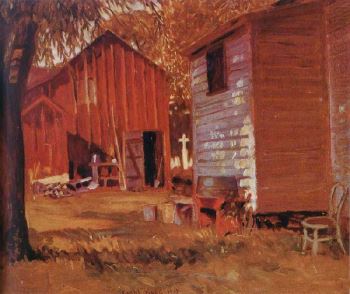
In 1920, Wood took a long-awaited trip to Europe for the summer. He returned to France in 1923-1924 to take classes at the Académie Julian in Paris, and continued his travels in Italy. During this period, he painted in an Impressionist-inspired style, focusing on landscapes. Though his style changed significantly over time, the decorative patterns of foliage and light seen in his early work remain a feature of his mature style.
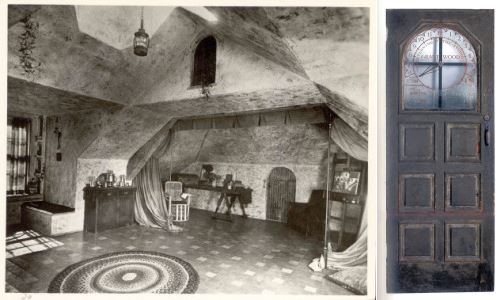
In 1925, Wood gave up teaching to focus on his art full-time, encouraged by his friend David Turner - described by Wanda Corn as "the savvy and energetic mortician" - who acted as a sort of agent for the artist. Turner gave Wood the use of the carriage house next to his funeral home. Wood transformed the space into a quirky, efficient, uniquely decorated artist's studio. After he returned from his final trip to Paris in 1926, he told his Cedar Rapids friend, journalist William Shirer that "like a revelation, my neighbors in Cedar Rapids, their clothes, their homes, the patterns on their table cloths and curtains, the tools they used. I suddenly saw all this commonplace stuff as material for art. Wonderful material!" The artist established his signature personal style around this time, which included denim overalls - the practical, utilitarian style of dress seen around the region, thus casting himself in the Regionalist mold.
He became the city's versatile, all-purpose artist, painting murals, designing stained glass windows, taking portrait commissions, and decorating homes. The support of the community as a whole, both like-minded artists and individuals willing to pay him for work, further encouraged Wood's identification with Regionalism. As art historian Joni Kinsey notes, "artistic cultivation...really could be achieved in an area known primarily for agricultural cultivation, and both were rendered more authentic and compelling by their alliance." Wood's subjects were drawn from stereotypes of the region - farmers, gossipy old ladies, small-town bankers, Shriners, masons and the like - but he treated them with affection and humor, rather than the disdain seen in contemporary literature produced by ex-Midwesterners like Carl Van Vechten and Sinclair Lewis.
The artists of Cedar Rapids were not alone in this belief in authentic, local-level cultivation of culture and were part of a much larger cultural trend between the world wars. Particularly through the New Deal years, both emotional and economic recovery from the Great Depression hinged upon national identity through regional achievement.
Although he'd committed to regional subject matter, a final journey to Europe - this time, to Germany - inspired Wood's mature style. In 1928, he travelled to Munich to oversee the fabrication of a stained glass window design for the Cedar Rapids Veterans Memorial Building. The precise realism of the Flemish masterworks held at the Alte Pinakothek by Hans Memling, Hans Holbein, and Albrecht Dürer struck Wood with "the lovely apparel and accessories of the Gothic period," and he said that the style reminded him of his own work as a child, before he was taught to use a "soft, evocative style."
Mature Period
Wood's profile soon leapt from local jack-of-all-trades to nationally recognized Regionalist painter. In 1930, American Gothic won a medal at the Art Institute of Chicago's annual exhibition. The artist was then 39, and this was only his third painting exhibited outside his home state. The Institute promptly purchased the work, elevating Wood's reputation exponentially. With his new-found recognition, Wood joined up with Ed Rowen - a prominent figure in Cedar Rapids art circles, and future head of the Fine Arts Section of the Public Buildings Administration - and other artists to form the Stone City Art Colony. Located near Wood's rural hometown, the artists lived in charming white-painted wagons, and taught classes through Coe College. The colony attracted artists from throughout the Midwest, including John Steuart Curry, a Kansas artist who would soon - along with Wood and Thomas Hart Benton of Missouri - stand as a representative of Regionalist art.
Between 1930 and 1934, Wood painted several of the works he is best known for - Arnold Comes of Age (1930), Victorian Survival (1931), Appraisal (1931), Daughters of the Revolution (1932), Midnight Ride of Paul Revere (1931), and Dinner for Threshers (1934).
Beginning in 1934, his life changed dramatically when he was appointed director of the Public Works of Art Project (PWAP) mural project for Iowa and also became a professor of Art at the University of Iowa, Iowa City. Often described as a "shy bachelor," a euphemistic phrase to mask his homosexuality, Wood abruptly married Sara Maxon, a singer from Cedar Rapids in 1935, and moved to Iowa City, leaving the comfort and support of his hometown. Both his professorship and marriage proved tumultuous. He completed only one painting in the following three years, spending most of his first year in Iowa City renovating and decorating the pre-Civil War house he and his wife bought, turning it into a "modern-eclectic" environment, in the same grain as his studio in Cedar Rapids. A lounge chair he designed for his home, with an elongated ottoman, was briefly mass produced, marketed in 1938 with a cardboard cut-out of Wood. Other commercial opportunities, which the artist pursued for financial reasons, became more frequent. His fame also brought a commission from Steuben glass, part of a series of vases designed by 27 contemporary artists, including Henri Matisse.

In Iowa City, Wood immersed himself again with the arts community, joining the Times Club, a group of intellectuals that hosted guest speakers through the S.P.C.S. (Society for the Prevention of Cruelty to Speakers), publishing the Revolt Against the City (1935), a Regionalist Manifesto, and routinely exhibiting in major national exhibitions. The period, though, was not a happy one for Wood. His marriage ended after only three years; his beloved mother died, and he had little time for painting, prompting critics to question whether the artist had passed his prime. Although he did produce several notable works - Parson Weems' Fable (1939), Spring in the Country (1941), and Adolescence (1940), his numerous illustration projects and lithographs provided a target for critics who felt his work was too illustrational and his reputation too dependent upon media attention.
Late period and Death
The worst of Wood's personal troubles, though, stemmed from his own department at the University of Iowa. These disputes caused him distress up to his unexpected death in 1942 and also contributed to the diminution of his legacy in the art world. When Wood was hired in 1934, he was considered a "liberal" painter, working in a more modernist style than many of his colleagues. When a new administration was installed in 1936, he was cast as a "reactionary" by the new department chair, 30-year old Lester Longman, an historian of medieval Spanish art who preferred "internationalist" avant-garde modernism. Clashes on subject matter and teaching style escalated. In 1940, Wood wrote to Earl Harper, the Director of the School of Fine Arts, complaining of his department chair's "general disparagement of my work and what I am working for," and asking for the studio art and art history departments to be separated. The University was anxious to retain Wood, their most famous faculty member, but his request was denied. Instead, they sent him on sabbatical for the 1940-1941 academic year. Longman took Wood's absence as an opportunity to discredit Wood, publicly criticizing his paintings, showing slides at conference lectures to demonstrate where he worked from photographs.
Time magazine came to investigate some of the unflattering rumors. Although a story was never published, the nature of the "charges" became known. Longman's criticism of his work was less damning than his indication that Wood's "personal persuasions have nothing whatever to do with our granting his leave of absence." A more forward statement regarding Wood's homosexuality was recorded from a meeting with the University's president regarding the "strange relationship between Mr. Wood and his publicity agent." While opinion on style and modernism were debatable, homosexuality was the one accusation in 1940 that could have ruined Wood's reputation even by implication. The problems at the art department were otherwise carefully documented, and this statement is the only mention of Wood's personal life. Longman continued to undermine him by authoring articles calling upon defenders of "true art" to "attack" "reactionary" and "communazi" art, including Regionalism. He solicited written opinions from art historians with similar views on Regionalism - including Alfred Barr of the Museum of Modern Art and Lloyd Goodrich of the Whitney Museum - to submit to the University as "evidence to show that as an artist he [Wood] is not so important as his publicity would lead one to believe." They all agreed that Wood's "sensationalist" and "provincial" popularity was without "enduring worth."
Despite Longman's efforts, Wood, as well as Benton and Curry, remained "populist chic" with collectors at the time. Celebrities including Cole Porter, Alexander Woolcott and Katherine Hepburn all acquired his work. In 1941, Wood was given a new title and studio and was removed from Longman's supervision. Wood's productivity was just returning to normal when he was diagnosed with pancreatic cancer that October. He died months later, in February on 1942, just short of his fifty-first birthday.
The Legacy of Grant Wood
Wood remains one of the most loved and most controversial of the American Regionalist painters. American Gothic (1930) is equally superlative, as arguably the most iconic work of modern American art, not to mention the most parodied. But the professional scuffles he endured at the University of Iowa regarding both his artistic merit and sexuality colored his historical reputation, putting him, as some writers have phrased it, in a constant state of rediscovery. The most enduring element of Charles Longman's crusade to discredit Wood came via one of his protégées, Horst Janson. In the early 1940s, Janson wrote several articles characterizing Wood and Regionalism as fascist. He went on to teach at New York University's Institute of Fine Arts, and later authored the widely used survey text, The History of Art. His opinion of Wood not only resulted in the artist not being mentioned in the text, he also included Regionalism in a single, rather negative paragraph, minimizing a distinctive strain of modern American painting for generations of students.
Despite this, Wood's realist style and the ethos of Regionalism became the "house style" for WPA projects. The program and its effect on artists lined up perfectly with Wood's personal philosophy of community and collaboration between artists. Artist James Brooks wrote in "Artists at Work" that the Federal Art Projects "took competition between artists out of the art world, so we started to see ourselves as part of a whole." Franklin Delano Roosevelt felt that the program helped to bring art to all Americans, stating that citizens have been "taught to believe art was something foreign to America and themselves. They have discovered in the last few years that art is something in which they have a part. They have discovered their own towns in pictures painted by their sons, their neighbors." Though WPA art also fell out of favor - interestingly, not for being presumed to be fascist, like Wood, but Communist in influence - the projects put realist modernism in front of millions of Americans in post offices and federal buildings across the country.
Wood's teaching was a conduit for more specific, personal influence. As her professor, Wood encouraged Elizabeth Catlett - who earned an MFA in sculpture from University of Iowa - to draw subject matter from African American culture and her own experience. She became associated with Regionalism and left wing activism and was investigate by the House Committee on Un-American Activities in the 1950s.
In the catalogue for the 2018 Whitney Museum exhibition, Barbara Haskell argues that however well Wood's art provided a "window into American consciousness" during the Great Depression, the power of his work endures due to its "mesmerizing psychological dimension." Despite his deep engagement with his community, Wood, in hindsight, communicates an "eerie sense of silence and isolation." In his meticulously observed images fused with "imagined memories of childhood, he crafted unsettling images of estrangement and apprehension that pictorially manifest the disquiet of modern life." This trend within Wood's work can be seen reflected in later American realist artists including Andrew Wyeth and George Tooker.
Wood's homosexuality opens another avenue for re-evaluative scholarship and has evolved considerably in the past three decades. In the 1990s, acclaimed art historian Robert Hughes first art-historically "outed" Wood, describing him as "a timid and deeply closeted homosexual," and described his work as "an exercise in sly camp, the expression of gay sensibility so cautious that it can hardly bring itself to mock its subjects openly." This characterization has since been seen as unfairly ignoring the cultural context of the 1930s, when discretion about sexuality was the rule. More recent appraisals, such as Henry Adams's, have looked more to the work and less to personal judgement, arguing that "homosexual feelings fundamentally shaped [Wood's] artistic vision, and ... his masterpieces are permeated with what might be termed a homosexual outlook, which is evident in their play of double meanings, with sexual ambiguities, and their camp sense of humor." Art historian Richard Meyer more recently disagreed, stating that Wood's sexuality was not a code by which to interpret his work, and cautioned against microscopic searches for expressions of sexuality in his art. Meyer states that bringing Wood "out of the art-historical closet is understandable, even commendable," but that scholars "should not lose sight of the intricate play of silence and suggestion, ambiguity and avoidance, that shaped Wood's life and art." Sighting Christopher Hommerding, he points out that "gay" was not yet an identity, and trying to reconstruct the artist as such would "wipe away the fact that public discourse of American art in the 1930s did not allow for any affirmative discussion of same-sex desire or experience."
Influences and Connections

-
![Hans Memling]() Hans Memling
Hans Memling -
![Albrecht Dürer]() Albrecht Dürer
Albrecht Dürer - Ernest Bachelder
- Charles Cumming
-
![Thomas Hart Benton]() Thomas Hart Benton
Thomas Hart Benton -
![John Steuart Curry]() John Steuart Curry
John Steuart Curry - Marvin Cone
- Ed Rowen
-
![Elizabeth Catlett]() Elizabeth Catlett
Elizabeth Catlett - Dale Nichols
- Aaron Pyle
- John Rogers Cox
 Ask The Art Story AI
Ask The Art Story AI